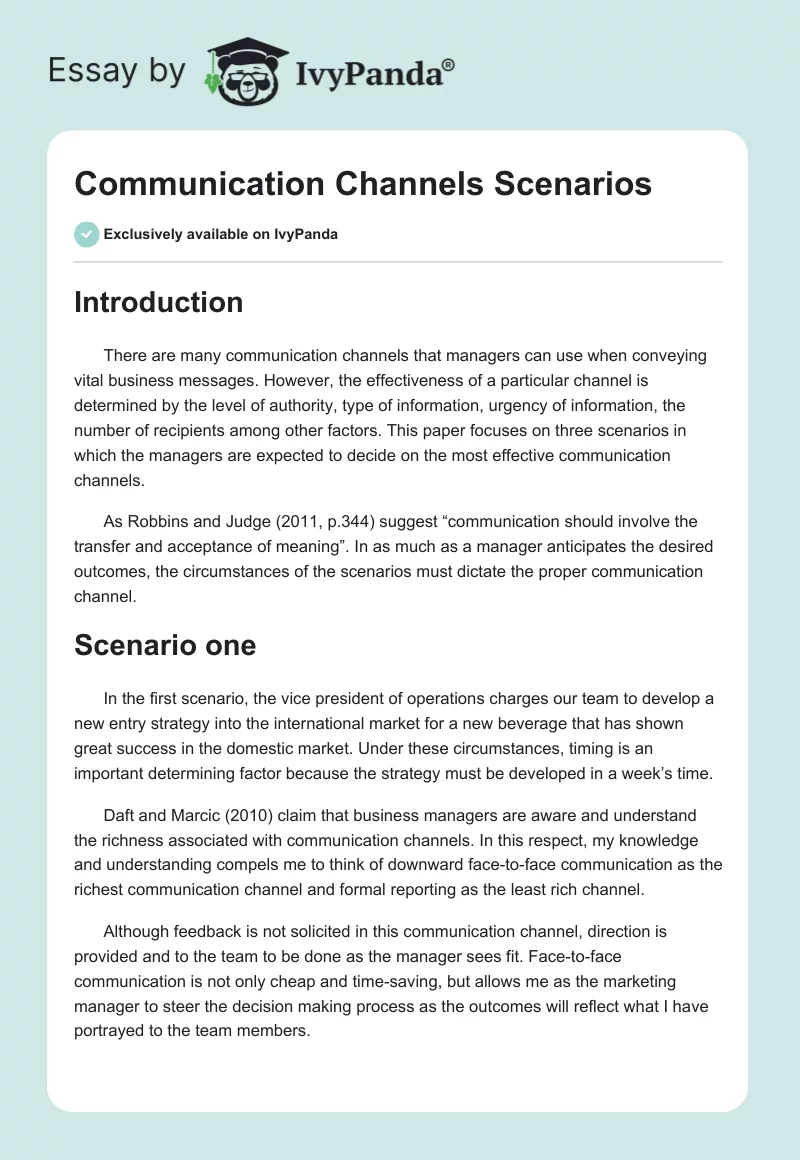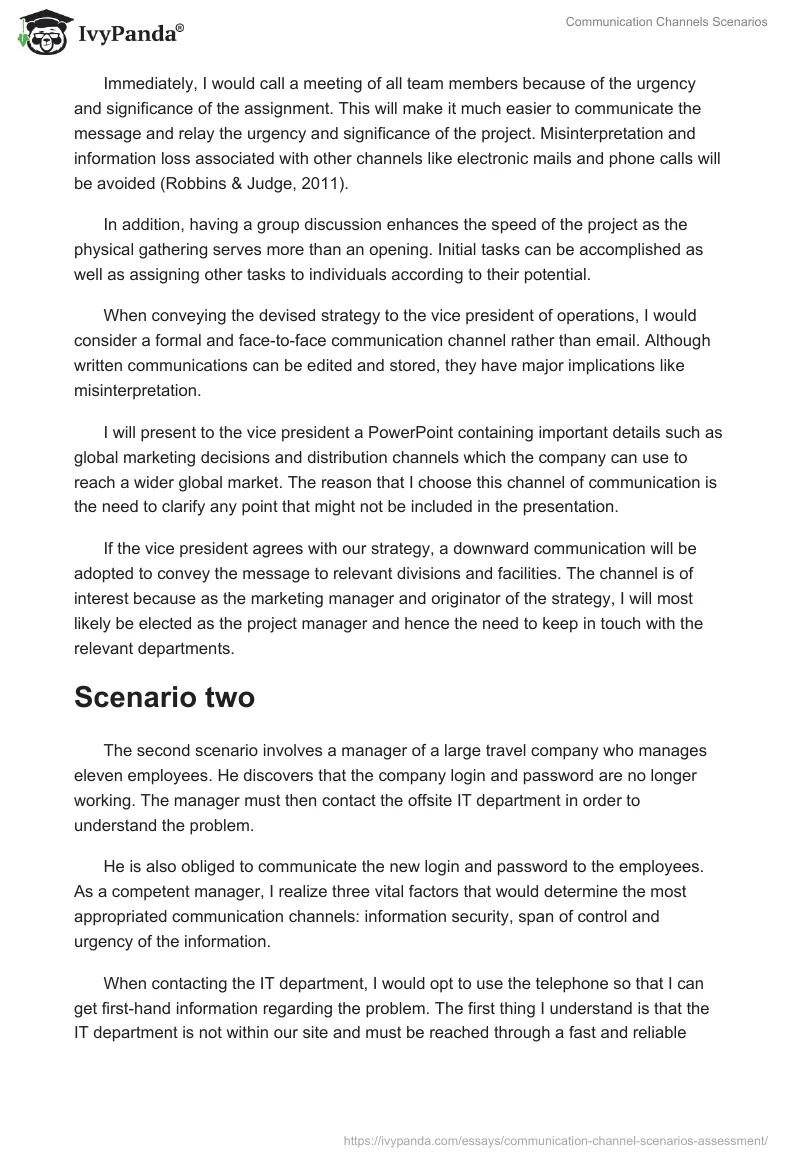Introduction
There are many communication channels that managers can use when conveying vital business messages. However, the effectiveness of a particular channel is determined by the level of authority, type of information, urgency of information, the number of recipients among other factors. This paper focuses on three scenarios in which the managers are expected to decide on the most effective communication channels.
As Robbins and Judge (2011, p.344) suggest “communication should involve the transfer and acceptance of meaning”. In as much as a manager anticipates the desired outcomes, the circumstances of the scenarios must dictate the proper communication channel.
Scenario one
In the first scenario, the vice president of operations charges our team to develop a new entry strategy into the international market for a new beverage that has shown great success in the domestic market. Under these circumstances, timing is an important determining factor because the strategy must be developed in a week’s time.
Daft and Marcic (2010) claim that business managers are aware and understand the richness associated with communication channels. In this respect, my knowledge and understanding compels me to think of downward face-to-face communication as the richest communication channel and formal reporting as the least rich channel.
Although feedback is not solicited in this communication channel, direction is provided and to the team to be done as the manager sees fit. Face-to-face communication is not only cheap and time-saving, but allows me as the marketing manager to steer the decision making process as the outcomes will reflect what I have portrayed to the team members.
Immediately, I would call a meeting of all team members because of the urgency and significance of the assignment. This will make it much easier to communicate the message and relay the urgency and significance of the project. Misinterpretation and information loss associated with other channels like electronic mails and phone calls will be avoided (Robbins & Judge, 2011).
In addition, having a group discussion enhances the speed of the project as the physical gathering serves more than an opening. Initial tasks can be accomplished as well as assigning other tasks to individuals according to their potential.
When conveying the devised strategy to the vice president of operations, I would consider a formal and face-to-face communication channel rather than email. Although written communications can be edited and stored, they have major implications like misinterpretation.
I will present to the vice president a PowerPoint containing important details such as global marketing decisions and distribution channels which the company can use to reach a wider global market. The reason that I choose this channel of communication is the need to clarify any point that might not be included in the presentation.
If the vice president agrees with our strategy, a downward communication will be adopted to convey the message to relevant divisions and facilities. The channel is of interest because as the marketing manager and originator of the strategy, I will most likely be elected as the project manager and hence the need to keep in touch with the relevant departments.
Scenario two
The second scenario involves a manager of a large travel company who manages eleven employees. He discovers that the company login and password are no longer working. The manager must then contact the offsite IT department in order to understand the problem.
He is also obliged to communicate the new login and password to the employees. As a competent manager, I realize three vital factors that would determine the most appropriated communication channels: information security, span of control and urgency of the information.
When contacting the IT department, I would opt to use the telephone so that I can get first-hand information regarding the problem. The first thing I understand is that the IT department is not within our site and must be reached through a fast and reliable channel. Telephone as a channel of communication will enable me to reach the relevant personnel immediately (Daft & Marcic, 2010).
Secondly, information about company login and password is vital and requires high security. Therefore, a telephone call will guarantee a high level of confidentiality (Deswarte, Cuppens & Jojadia, 2004).
In addition, the information under question is vital to all business operations and the problem might delay almost all the activities. In response to this need, a telephone allows me to keep in constant touch with the IT department and perhaps press them to speed up in case of delays.
When communicating with the employees, downward communication will be the most appropriate to keep them informed and provide them with new login and password details (Robbins & Judge, 2011, p.344). When the new instructions will be provided, I will pass the details to the assistant manager who would then pass to other employees.
For instance, I might choose to send an email to the assistant manager who will then send a priority email to the rest of the employees as they have an up and running email that can be used.
This is the best channel of communication because, as the manager, I would be required to report to my superior. While my designated employee is conveying the message to others, I would be explaining the problem and the solution to my superior.
Scenario three
The third scenario involves a business owner of an editing company having ten employees working for him. He critically needs to reduce the workforce in order to raise profit margins.
A close assessment of the situation reveals two important factors that determine the appropriate communication channel: number of recipients and nature of the information. Robbins and Judge (2011) are of the opinion that non-routine messages are complicated and have potential misunderstanding and managers can therefore communicate them effectively by selecting rich channels.
When informing the employees about the reduction of the workload, I would use face-to-face channel of communication.
This type of channel has the highest richness while formal reports have the least richness. Information about employee reduction is non-routine and might follow the suggestion put forward by Robbins and Judge. There is likelihood that I will be misquoted if I used other forms of communication such as electronic mails. Furthermore, the number of employees is small and I can easily convene a meeting to relay the message.
However, when informing the affected employees that they are being let go, I will use a formal method of communication. I will send a letter to each employee that will be affected by the reduction. This is an appropriate channel of communication because the subject is emotional and explaining the situation to each employee formally is an indication that I care.
Indeed, no feature of communication has more meaning and significance than emotions (Nielsen, 2008). Robbins and Judge (2011) identified emotions as a major barrier to effective communication that managers should overcome by selecting channels that eliminate emotional judgment such as formal letters.
References
Daft, R. L. & Marcic, D. (2010). Understanding Management. Florence, KY: Cengage Learning.
Deswarte, Y., Cuppens, F. & Jojadia, S. (2004). Information security management, education and privacy: IFIP 18th World Computer Congress: TC11 19th International Information Security Workshops, 22-27 August 2004, Toulouse, France. Florence, KY: Springer.
Nielsen, J. (2008). Effective Communication Skills. Bloomington, IN: Xlibris Corporation.
Robbins, S. P., & Judge, T. A. (2011). Organizational Behavior, Communication. Upper Saddle River, NJ: Pearson Education.


